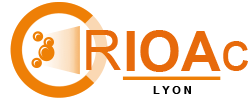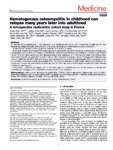Hematogenous osteomyelitis in childhood can relapse many years later into adulthood
To describe the epidemiological, clinical, laboratory, and radiological features and the management of adult patients who
experienced a relapse between 2003 and 2015 of an acute hematogenous osteomyelitis acquired in childhood.
A retrospective multicentric cohort study was conducted in 5 centers in France.
Thirty-seven patients were included. The median age was 40 years (28–56), and 26 (70%) were male. The first site of infection was
the distal femur (n=23, 62%). The median time between the osteomyelitis in childhood and the relapse in adulthood was 26 years
(13–45). Thirty-four (92%) patients reported inflammatory local clinical manifestations, 17 (46%) draining fistula, 10 (27%) fever. Most
patients had intramedullary gadolinium deposition (with or without abscess) on magnetic resonance imaging. Most relapses were
monomicrobial infections (82%). Staphylococcus aureus was the most commonly found microorganism (82%), expressing a small
colony variant phenotype in 3 cases. Most patients (97%) had a surgical treatment, and the median duration of antibiotics for the
relapse was 12 weeks. All patients had a favorable outcome, no patient died and no further relapse occurred. We count 2 femoral
fractures on osteotomy site.
Osteomyelitis in childhood can relapse later in adulthood, especially in patients with lack of care during the initial episode.
Osteotomy and prolonged antimicrobial therapy are required for clinical remission.



